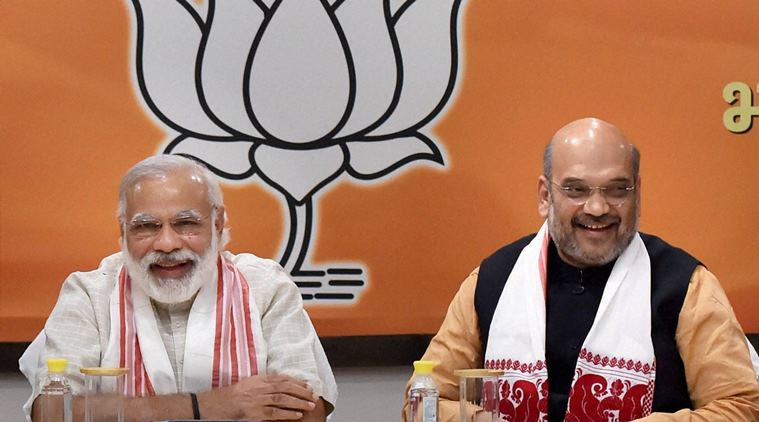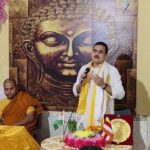HOW THE LOTUS BLOOMED: A LOOK BACK IN TIME
- By : Anirban Ganguly
- Category : Articles

Ever since its inception, the BJP has seen decades of struggle and the Lotus did bloom in 2014. Ever since then, the party under Modi and Shah has become a bridge between the Government and the people
It was on April 6, 1980, at the Kotla grounds in Delhi that the decision was taken, by members of the erstwhile Jana Sangh, to part company with the Janata Party. It was on that day that the Bharatiya Janata Party (BJP) was formed with members and workers of the erstwhile Jana Sangh coming together to chart out a new alternative for Indian politics. The party founded by Syama Prasad Mookerjee, nurtured and expanded by Pandit Deendayal Upadhyaya and a host of other pracharaks and workers had now metamorphosed into a new form. Its workers and leaders, displaying an indomitable spirit of struggle, resolved to again pick up the threads of their ideological and political vision and to mount anew a struggle for reclaiming India.
At a time when authoritarianism had renewed its assault on Indian democracy through the Indira Gandhi-led Congress dispensation while the Janata Party dispensation wallowed in confusion, this resolve marked a new political era for India, an era which saw its first high water mark between 1996 and 2004 and a climax in 2014 with the BJP forming a majority Government on its own for the first time. Few among those who had gathered at Kotla maidan on April 6, 1980, would have dreamt of the possibility of being in power someday and even less among them would have ever imagined a result such as one saw in 2014 to be ever possible.
Earlier that month, in April 1980, the National Executive of the Janata Party ‘adopted a resolution prohibiting members of RSS’ from continuing in the Janata Party. The fear entertained by a group led by Chandrashekhar and other socialists within the Janata Party was that after the split of the party following the secession of the Charan Singh faction, the ‘erstwhile Jana Sangh would capture the party on account of its mass base and large army of dedicated workers.’ Having practically no base of their own, limited to an ideological circle, these leaders were obsessed with the spectre of being sidelined by the more popular members of the erstwhile Jana Sangh.
The members of the Jana Sangh objected to this condition, for them the dual membership issue had been settled at the time of the merger itself and, therefore, raising it at this point of time, smacked of opportunism and betrayal. Moreover in the coalition even though ‘it was the single largest constituent of the Janata Party and had a larger popular base in the country’; the Jana Sangh had never negotiated for a proportionate share either in the Janata Government or in the Janata Party.
The stifling arrangement thus ended with the formation of the BJP. ‘The party had no organisation of its own but lakhs of erstwhile Jana Sangh workers were there and had to start from a scratch.’ The first plenary was convened in Mumbai towards the end of December 1980 (28-30th) and the interim period between April and December was utilised to mobilise cadres, enrol members and set up units across the country. It is estimated that about 25 lakh members were enrolled in the BJP during this period. It was a first membership drive for the new party and the response was exciting.
The Mumbai plenary, attended by over 55,000 workers from across the country, was an impressive gathering. The inaugural of the plenary was attended by none other than Muhammedali Currim Chagla, veteran Congressmen, legendary jurist, sometime education Minister in Nehru’s Cabinet and later Foreign Minister in Indira’s Cabinet. Then in his advanced years, Chagla had opposed Emergency and later welcomed the formation of the BJP as an alternative to the Congress which, he felt, had increasingly become a party of ‘hypocrites, opportunists and sycophants.’ Chagla’s 40-minutes speech at the convention was the climax in which he argued that the BJP has ‘completely established its credentials as the alternative that can replace’ the Congress Government.
The rallying cry for the new party was ‘Sanghatan’, ‘Sangharsh’ and ‘Samarachana’ (organisation, struggle, constructive work). Atal Bihari Vajpayee’s presidential address was an inspiring one, articulating the symbols that would inspire workers to action, Vajpayee also pointed towards a greater dawn. ‘With the Constitution of India in one hand and the banner of equality in the other,’ Vajpayee told those gathered, “let us get set for the struggle. Let us take inspiration from the life and struggle of Chhatrapati Shivaji Maharaj. Let Mahatma Phule be our guide in our crusade for social justice…standing on the shores of this Ocean beneath the Western Ghats, I can say this with confidence about the future: Darkness will be dispelled, the Sun will rise and the Lotus shall bloom.” Through years and decades of struggle, the Lotus did eventually bloom and its finest hour came in the summer of 2014, when for the first time since 1980, it had reached its electoral pinnacle.
Interestingly for the BJP, the pinnacle of 2014 did not lead it into the plateau of complacency. Since that summer, the party has won State after State, has formed Government or is part of Government in 21 States and has encompassed over 70 per cent of the population. It has increased and expanded its base into regions that was considered difficult for it, has emerged to become the largest political party in the world, widened and diversified its activities, continued its quest for an uninterrupted ideological reiteration and restatement, inspired workers and leaders to be always on the move and in action mode through innovative and imaginative programmes and outreach activities, it has evolved itself into a movement that is not only political in nature but has also displayed deep commitment towards social transformation. This multi-expansion and re-calibration has been the result of BJP chief Amit Shah’s own indefatigable political initiatives and peregrinations.
Instead of becoming a complacent appendage to its Government, the party has emerged as one of the most imaginative and energetic vehicle and bridge for carrying forward Prime Minister Narendra Modi’s message of transformative governance and the governance philosophy of Antyoday — the inspirational fountain of the party’s vision and action of governance. The party under Shah has succeeded in becoming both a bridge between the Government and the people, a conveyor of governance initiatives and ideas and an emissary of the feedback and emotions of the people that it absorbs and discerns. So compelling is its narrative of governance, so sturdy is its political strength that the BJP continues to attract leaders and workers from other parties, much to the chagrin of parties and leaders who have been reduced to a rump in Parliament and across the country.
One of the early observations that Shah had made, when he took over the presidency of the party in July 2014, was that peaks and pinnacles are reached not for rest and laurels, but to leap towards greater heights. ‘We should not consider having reached our peak, until the BJP had spread itself in terms of governance and being in power across the length and breadth of the country. Our thoughts, our ideology, our vision, our governance philosophy, our struggle to end the politics of dynasticism, casteism and of appeasement must eventually be successful, only then shall we come nearer the goal with which our political and ideological elders had launched the party, the goal of making India pre-eminent’ is what Shah has often reminded young workers, leaders and members of the party over the last four years through thousands of interactions that he has had with them.
As its steps into its 38th year, the BJP prepares for the great leap of 2019, a leap from the peak that will carry it to a greater peak…

















